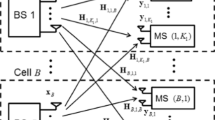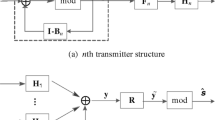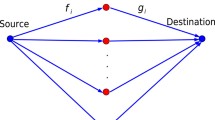Abstract
In this paper, the closed-form parameterizations to the Pareto boundary for the two-user multiple-input single-output interference channel are studied. Firstly, for the equivalent channel model with each transmitter having only two antennas, the weighted sum-rate maximization (WSRMax) problem is reformulated with newly defined angle variables. Then, a centralized weighted leakage-plus-noise-to-signal ratio minimization (WLNSRMin) algorithm is proposed to find a locally optimal weighted sum-rate point. Each step of the algorithm is solved by evaluating closed-form expressions. A distributed algorithm is also given to avoid the exchange of the channel state information (CSI) between transmitters. Numerical results show that the centralized WLNSRMin algorithm converges to a local optimum of the WSRMax problem after a few iterations and the distributed algorithm achieves a performance very close to that of the centralized algorithm with only local CSI.



Similar content being viewed by others
References
Jorswieck, E. A., Larsson, E. G., & Danev, D. (2008). Complete characterization of the Pareto boundary for the MISO interference channel. IEEE Transactions on Signal Processing, 56(10), 5292–5296.
Zhang, R., & Cui, S. (2010). Cooperative interference management with MISO beamforming. IEEE Transactions on Signal Processing, 58(10), 5450–5458.
Mochaourab, R., & Jorswieck, E. A. (2011). Optimal beamforming in interference networks with perfect local channel information. IEEE Transactions on Signal Processing, 59(3), 1128–1141.
Zakhour, R., & Gesbert, D. (2009). Coordination on the MISO interference channel using the virtual SINR framework. In Proceedings of the ITG Workshop on Smart Antennas (WSA09), Berlin, (pp. 1–7).
Shang, X., Chen, B., & Poor, H. V. (2011). Multiuser MISO interference channels with single-user detection: Optimality of beamforming and the achievable rate region. IEEE Transactions on Information Theory, 57(7), 4255–4273.
Shang, X., & Poor, H. V. (2013). Noisy-interference sum-rate capacity for vector Gaussian interference channels. IEEE Transactions on Information Theory, 59(1), 132–153.
Lindblom, J., Karipidis, E., & Larsson, E. G. (2011). Closed-form parameterization of the Pareto boundary for the two-user MISO interference channel. In Proceedings of the IEEE International Conference acoustics, speech and signal processing (ICASSP), Prague, Czech (pp. 3372–3375).
Mochaourab, R., & Jorswieck, E. A. (2011). Walrasian equilibrium in two-user multiple-input single-output interference channels. In Proceedings of the IEEE ICC, Kyoto, Japan (pp. 1–5).
Zeng, Y., Yetis, C. M., Gunawan, E., Guan, Y. L., & Zhang, R. (2013). Transmit optimization with improper Gaussian signaling for interference channels. IEEE Transactions on Signal Processing, 61(11), 2899–2913.
Annapureddy, V. S., & Veeravalli, V. V. (2011). Sum capacity of MIMO interference channels in the low interference regime. IEEE Transactions on Information Theory, 57(5), 2565–2581.
Björnson, E., Jaldén, N., Bengtsson, M., & Ottersten, B. (2011). Optimality properties, distributed strategies, and measurement-based evaluation of coordinated multicell OFDMA transmission. IEEE Transactions on Signal Processing, 59(12), 6086–6101.
Shi, Q., Razaviyayn, M., Luo, Z., & He, C. (2011). An iteratively weighted MMSE approach to distributed sum-utility maximization for a MIMO interfering broadcast channel. IEEE Transactions on Signal Processing, 59(9), 4331–4340.
Christersen, S. S., Agarwal, R., de Carvalho, E., & Cioffi, J. M. (2008). Weighted sum-rate maximization using weighted MMSE for MIMO-BC beamforming design. IEEE Transactions on Wireless Communications, 7(12), 1–7.
Lindblom, J., & Karipidis, E. (2010). Cooperative beamforming for the MISO interference channel. In Proceedings of the European wireless conference (EW10), Lucca (pp. 631–638).
Luenberger, D. G. (2003). Linear and nonlinear programming. Berlin: Springer.
Zhu, H., & Wang, J. (2012). Chunk-based resource allocation in OFDMA systems—part II: Joint chunk, power and bit allocation. IEEE Transactions on Communications, 60(2), 499–509.
Boyd, S., & Vandenberghe, L. (2004). Convex optimization. Cambridge: Cambridge University Press.
Lee, B. O., Je, H. W., Shin, E.-S., & Lee, K. B. (2009). A novel uplink MIMO transmission scheme in a multicell environment. IEEE Transactions on Wireless Communications, 8(10), 4981–4987.
Karipidis, E., Gründinger, A., Lindblom, J., & Larsson, E. G. (2009). Pareto-optimal beamforming for the MISO interference channel with partial CSI. In Proceedings of the IEEE international workshop on computational advances in multi-sensor adaptive processing (CAMSAP), Aruba, Dutch Antilles (pp. 5–8).
Acknowledgements
This work was supported in part by National Natural Science Foundation of China (NSFC) (Grant Nos. 61501113, 61271205, 61521061, 61372100, 61571120), and Jiangsu Provincial Natural Science Foundation (Grant Nos. BK20150630, BK20151415).
Author information
Authors and Affiliations
Corresponding author
Appendices
Appendix 1: Proof of Proposition 2
Considering the second entry of \(\mathbf{h }_{kk}\), one has
where \(\left( a\right)\) is because \(\tilde{\mathbf{h }}_{kj}^H\tilde{\mathbf{h }}_{kk}\) is a scalar, \(\left( b\right)\) is by the Cauchy–Schwartz inequality \(|\langle \tilde{\mathbf{h }}_{kk},\tilde{\mathbf{h }}_{kj}\rangle |^2\le \Vert \tilde{\mathbf{h }}_{kk}\Vert ^2\Vert \tilde{\mathbf{h }}_{kj}\Vert ^2\), equality holds if and only if \(\tilde{\mathbf{h }}_{kk}\) and \(\tilde{\mathbf{h }}_{kj}\) are linearly dependent. Since the linearly independent channels are considered in this paper, the second entry of \(\mathbf{h }_{kk}\) is a positive real number. Combining this property and Proposition 1, we can rewrite the equivalent channel vectors \(\mathbf{h }_{kk}\) and \(\mathbf{h }_{kj}\) as in (18) and (19) respectively. This completes the proof.
Appendix 2: Proof of Theorem 1
Firstly, we reformulate the optimization problem (17) with the newly defined angle variable \(\varphi _k\). For linearly independent channels, the original non-convex optimization problem (17) is equivalent to the following optimization problem for the same rate weight \(\mu _k\) [5]:
where \({{\mathbf{S }}}_k=\mathbf{w }_k\mathbf{w }_k^H\), and the power constraint at the \({\text {BS}}_k\) is \({\text {tr}}({{\mathbf{S }}}_k)= P_k\) which results from that full transmit power should be used to obtain the optimal solution to the WSRMax problem (17) when the channels are linearly independent [3, 11].
-
(1)
Useful signal power From the definition (22), the useful signal power term of (45) can be expressed with \(\varphi _k\) as
$$\begin{aligned} u_k^2=\mathbf{h }_{kk}^H {{\mathbf{S }}}_k \mathbf{h }_{kk}=P_k\sin ^2{\varphi _k}. \end{aligned}$$(46)
-
(2)
Interference power Assume that the singular-value decompositions (SVDs) of \(\mathbf{h }_{kk}\)
and \(\mathbf{h }_{kj}\) are
and
where \(\mathbf{U }_{kk}\) and \(\mathbf{U }_{kj}\) are \(2\times 2\) unitary matrices. Define
where all \(\alpha ,\, \beta ,\, \hat{S}_{11},\, \hat{S}_{21}\) and \(\hat{S}_{22}\) are scalars. Considering the useful signal power term in (46), we have
Substituting (49), (50) and (51) into the interference power term of (45), we have
where (a) results from \({\text {tr}}({{\mathbf{S }}}_k)={\text {tr}}(\hat{{{\mathbf{S }}}}_{k})=\hat{S}_{11}+\hat{S}_{22}=P_k\). With the definition of
we have
where (a) results from \(\tilde{S}_{21}\alpha + \alpha ^H\tilde{S}_{21}^H \ge -2|\tilde{S}_{21}||\alpha |\) since \(\left( \tilde{S}_{21}\alpha + \alpha ^H\tilde{S}_{21}^H \right) ^2=\left( 2\text {Re}(\tilde{S}_{21}\alpha ) \right) ^2 \le 4|\tilde{S}_{21}|^2|\alpha |^2\), and (b) is due to \(\hat{S}_{11}\hat{S}_{22}= u_k^2(P_k-u_k^2) \ge |\hat{S}_{21}|^2=|\tilde{S}_{21}|^2\) since \(\hat{{{\mathbf{S }}}}_k\succeq 0\). The equality of (a) holds if and only if \(\tilde{S}_{21}\alpha\) is non-positive real number, i.e.,
The equality of (b) holds under the condition
where the choice of \(\tilde{S}_{21}\) ensures that (55) is satisfied. Under the conditions of (55) and (56), the minimum of the interference power term in (54) can be given by
where (a) results from \(\alpha = d_k(a_k-i b_k)\) and \(|\beta | = \sqrt{\Vert \mathbf{h }_{kj} \Vert ^2 - |\alpha |^2}\) which are obtained from (49), (b) and (c) result from (20) and (22), respectively.
-
(3)
Value range of \(\varphi _k\) The value range of \(u_k\) is
$$\begin{aligned} u_k\in \left[ 0,\sqrt{P_k}\Vert \mathbf{h }_{kk}\Vert \right] =\left[ 0,\sqrt{P_k}\right] , \end{aligned}$$(58)
which results from \(\Vert \mathbf{h }_{kk}\Vert =1\). Combined with the definition (22), it can be seen that the value range of \(\varphi _k\) is
Combining (45), (46), (57) and (59), the WSRMax problem (17) can be reformulated with the angle variables \(\varphi _k\) as in (23). Next, we prove that the optimal beamforming vector \(\mathbf{w }_k^{*}\) has the form as in (24). From (47), we have
where \(u_{ij}=\left( \mathbf{U }_{kk}\right) _{ij}\). Due to the properties of unitary matrix, the unitary matrix \(\mathbf{U }_{kk}\) can be given by
Combining (50), (51), (52) and (62), we have
Then, \({{\mathbf{S }}}_k\) can be obtained from (50), (61) and (63) as
where \(B=\sin {(\varphi _k-\theta _k)}\cos {(\varphi _k-\theta _k)},\, (a)\) results from \(\cos {\theta _k}=\sqrt{a_k^2+b_k^2},\, \sin {\theta _k}=c_k,\, \sin {\eta _k}=b_k/\sqrt{a_k^2+b_k^2},\, \cos {\eta _k}=a_k/\sqrt{a_k^2+b_k^2},\, \sin {\varphi _k}=u_k/\sqrt{P_k}\) and \(\cos {\varphi _k}=\sqrt{(P_k-u_k^2)/P_k}\), which can be obtained from (20), (21) and (22), respectively. Moreover, since it has been proved in [1] that for the two-user MISO IC any point on the Pareto boundary is achievable with the weighted sum of the MRT and ZF beamforming vectors with some set of real-valued parameters which are in the range of [0, 1], and the MRT and ZF beamforming vectors at \({\text {BS}}_k\) can be given by
where \(\varPi _{{\mathbf{h }}_{kj}}^{\perp }\,\triangleq\,{\mathbf{I}} -{\mathbf{h}}_{kj}\left( {\mathbf{h }}_{kj}^H {\mathbf{h }}_{kj} \right) ^{-1} {\mathbf{h }}_{kj}^H\) is the orthogonal projection onto the orthogonal complement of \(\mathbf{h }_{kj}\), the optimal beamforming vectors can be expressed as the following form without loss of optimality
where \(x_k,\, y_k\) and \(z_k\) are real numbers and \(z_k > 0\) which results from \(c_k> 0\). Therefore, the signal correlation matrix \({{\mathbf{S }}}_k^{*}\) can be given with \(\mathbf{w }_k^{*}\) by
Combining (64) and (68), we have
The remaining challenge is to solve the Eq. (69). From [14, 19], the range of useful signal power \(u_k^2\) obtained by the optimal beamforming vector is given by
Substituting (70) into (22) yields the range of the optimal angle variable \(\varphi _k^{*}\),
where (a) results from \(\Vert \mathbf{h }_{kk}\Vert ^2 = a_k^2 + b_k^2 + c_k^2 =1\). Since \(\theta _k = {\text {asin}}{(c_k)}\) which can be obtained from (20), we have \(0\le \varphi _k^{*} - \theta _k \le \frac{\pi }{2} - {\text {asin}}(c_k)\). Hence, \(\cos (\varphi _k^{*}-\theta _k)\ge 0\). Recalling that \(z_k> 0\), by solving the Eq. (70), we obtain
Consequently, the beamforming vector \(\mathbf{w }_k^{*}\) can be expressed with \(\varphi _k^{*}\) as in (24).
Rights and permissions
About this article
Cite this article
Li, J., Wang, D., Zhu, P. et al. Optimality Properties, Closed-Form Parameterizations and Distributed Strategy of the Two-User MISO Interference Channel. Wireless Pers Commun 96, 833–853 (2017). https://doi.org/10.1007/s11277-017-4204-5
Published:
Issue Date:
DOI: https://doi.org/10.1007/s11277-017-4204-5




